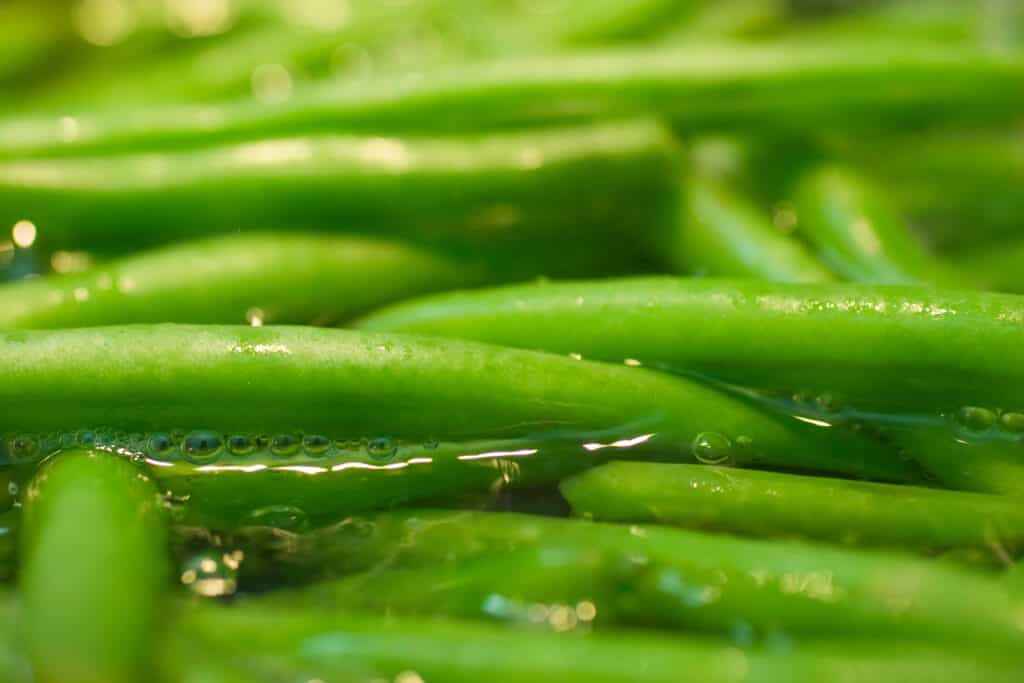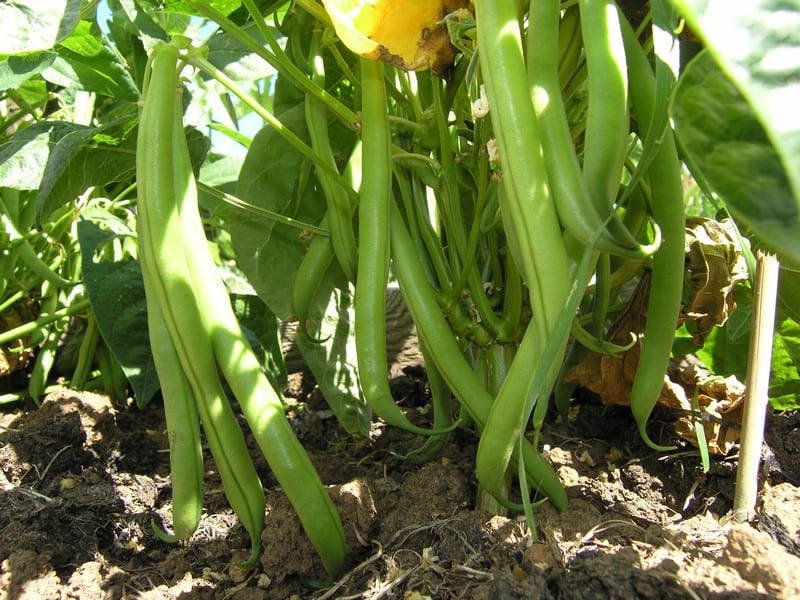Fresh, tender snap beans have a delicate flavor that is delicious eaten raw or just lightly cooked. Both the immature seeds and seed pods are edible.
Green beans are snap beans, but snap beans can also be yellow, purple, and splotched in multiple colors.

The peak season for fresh local snap beans is late spring through late fall.
Types of snap beans
- Green snap bean. There are many cultivars of this bean; all are green in color. Green snap beans were once commonly called “string beans” which referred to the tough filament or string that ran the length of some cultivars. The string is largely absent from snap beans today.
- Yellow snap bean. This bean is similar to the green snap bean except for its yellow color and somewhat waxy texture. That’s why yellow snap beans are also called wax beans.
- Purple snap bean. This bean has velvety skin which is dark, dark purple. When cooked, this bean turns green.
- Filet bean or French bean or haricot verts. This is a style of green bean that is exceptionally slender and stringless. These beans are usually ⅛ inch (.3 cm) in diameter. They have long been a favorite in France. There are yellow and purple filet-style beans. Haricot means “bean” in French and vert translates as “green.”
- Italian flat bean, Roma, or Romano bean. These beans have flattened pods, not plump. They can be green, yellow, or purple in color.
- Dragon Tongue bean and Tongue of Fire bean. The Dragon Tongue bean is yellow in color and similar to the yellow or wax bean but with violet splashes across its skin. The Tongue of Fire Bean is green-skinned with violet splashes.
- Dutch flat-pole bean. This green snap bean has flat, tender pods about 10 inches (25 cm) long. This bean is a favorite in the Netherlands.

How to choose snap beans
- There are many types of snap beans including purple, yellow, creamy white, and green, and snap beans can be flat or round.
- Snap beans are also called green beans but they are also called baby French green beans, filets, flat green beans, French beans, haricot verts (in French), Italian green beans, Romano beans, pole beans, bush beans, string beans, stringless beans, wax beans, and yellow beans.
- Probably the two most commonly grown beans are the green snap bean and the yellow or wax bean. Green snap beans are rarely called string beans anymore because the fibrous side strings have almost been wholly bred out of the species.
- All of these beans are called snap beans for the sound they make when they are broken in half.
- Select beans that are clean, crisp, well-shaped, and smooth. Green snap beans should have velvety skin.
- If beans have been snipped at the ends, the cut ends should be green and moist.
- Avoid snap beans where you can see the shape of the beans inside the pod. These beans are too mature to be eaten as fresh snap beans.
How to store snap beans
- Snap beans will keep in the vegetable compartment of the refrigerator for about 5 days.
- Wash the beans to maintain their moisture before storing them.
- Do not snap off the ends until you are ready to cook them.
- Snap beans can be blanched and frozen for up to 3 months.

Snap bean serving suggestions
- Eat snap beans raw or lightly cooked. Use snap beans in casseroles, braises, soups, and quiches.
- Serve snap beans plain or topped with plain for flavored butter or margarine, vinaigrette dressing, plain or flavored mayonnaise, white sauce, melted cheese or cheese sauce, sour cream, or plain yogurts.
- Serve snap beans alone or mixed with cooked onions, carrots, tomatoes, mushrooms, corn, celery, sweet bell peppers, pimientos, winter squash, water chestnuts, sliced almonds, bacon, or ham.
- You can serve fresh, raw sliced snap beans with a dipping sauce or you can sauté them and then toss them with diced potatoes and a little onion and bacon for a hot bean salad.
Favorite snap beans recipes
How to Can Green Snap Beans for Beginners
Snap bean cooking suggestions
- Simmer green beans for 5 to 15 minutes if whole, and 4 to 10 minutes if cut up. Add about 3 to 5 minutes to steam snap beans.
- Sauté or stir-fry snap beans after you have broken or cut them into small, uniform pieces.
- Simpler yet, just top and tail snap beans and cook them in boiling water for 5 minutes and serve them as an accompaniment to meat or poultry or fish. You can go wild by just adding a dab of butter.

How to simmer (quick boil) snap beans
- Wash and trim off the ends of the beans.
- Cook in rapidly boiling lightly salted water covered.
- Cook until bright green and crisply tender about 4 minutes; there should be some bite in the bean after cooking.
How to steam snap beans
- Wash and trim off the ends of the beans.
- Place a steam basket in a large pot with an inch or two of salted water; the water should not touch the basket.
- Cover and cook until the beans are bright green and crisp-tender, about 4 to 6 minutes.

How to sauté snap beans
- Wash and trim off the ends of the beans.
- Heat olive oil or butter in a skillet over medium heat.
- When the oil or butter is hot add the green beans.
- Cook and toss the green beans until bright green and crisp-tender, about 5 minutes or a bit longer
- Add minced garlic or chopped onion to the pan, season with salt and freshly ground black pepper, and cook for 1 additional minute. (You can also season with onion salt, garlic salt, or garlic powder during cooking.)
- Remove the pan from the heat and toss with the sea salt.
How to microwave snap beans
- Wash and trim off the ends of the beans.
- Place the beans in a microwave-proof bowl with about 2 tablespoons of lightly salted water.
- Cover with a lid or plastic wrap.
- Microwave on high for 2 minutes.
- Shake or stir the beans and continue to microwave on high for 1-minute intervals until the beans are bright green and tender.
Snap bean flavor partners
- Season snap beans with salt, pepper, onion, garlic, dill, marjoram, turmeric, savory, basil, paprika, oregano, tarragon, allspice, mustard, caraway seed, sesame seed, mace, nutmeg, mint, parsley, sage, rosemary, or thyme.
Snap bean nutrition
- Beans are rich in vitamins A, B, and C, and also calcium, phosphorus, iron, fiber, and protein.
- A medium serving of snap beans contains about 43 calories.

Get to know snap beans
- Snap beans are tender annuals that grow on bushes or vines depending upon the variety. The leaves are composed of three leaflets and the pods can be round, flat, or curved in shape. The pods are usually 3 to 8 inches (7.5-20 cm) long, pencil-thick to about ¾ inch (2 cm) in diameter. They can be colored green, yellow, purple, red, or green flecked with purple.
- Snap beans originated in Southern Mexico and Guatemala.
- The cultivation of snap beans dates to at least 8,000 B.C.
The botanical name of snap beans is Phaseolus vulgaris.
Also of interest:
How to Harvest and Store Beans
Related articles:
How to Plant and Grow Snap Beans
How to Harvest and Store Snap Beans
Bean Growing Problems: Troubleshooting
Five Ways to Quick Cook and Serve Snap Beans
How to Can Green Snap Beans for Beginners
Cooking and Serving Yard-Long Beans
How to Grow Chickpeas and Garbanzo Beans
How to Grow Broad Beans and Lima Beans
More kitchen tips:
Bring your harvest to the table. Kitchen prep tips and easy recipes for the vegetables you grow. Click below for vegetable prep and recipes you can use now.
- Almonds
- Apples
- Apricot
- Aprium
- Artichoke
- Arugula
- Asparagus
- Avocado
- Bamboo Shoots
- Banana
- Basil
- Beans, Dried
- Beans. Long
- Beans, Shell
- Beans, Snap
- Beets
- Bitter Melon
- Blackberry
- Bok Choy
- Broccoli
- Broccoli Raab
- Brussels Sprouts
- Cabbage
- Cardoon
- Carrots
- Cauliflower
- Celeriac
- Celery
- Chard
- Chayote Squash
- Cherimoya
- Cherries
- Chestnut
- Chickpea
- Chinese Cabbage
- Chives
- Cilantro
- Citron
- Clementine
- Collards
- Coriander
- Corn, Sweet
- Corn, Baby
- Corn Salad, Mache
- Cranberry
- Cress
- Cucumber
- Daikon
- Dandelion
- Dill
- Eggplant
- Endive, Belgian
- Endive and Escarole
- Fava Beans
- Fig
- Florence Fennel
- Garlic
- Ginger
- Grapefruit
- Grapes
- Guava
- Horseradish
- Jerusalem Artichoke
- Jicama
- Jujube
- Kale
- Kiwifruit
- Kohlrabi
- Kumquat
- Leeks
- Lemongrass
- Lemons
- Lettuce
- Lime
- Mache (Corn Salad)
- Mandarin Orange
- Mango
- Maple Syrup
- Marjoram
- Melons
- Michihili
- Mint
- Mizuna
- Mushrooms
- Mushrooms, Cremini
- Mustard Greens
- Napa Cabbage
- Nectarine
- Okra
- Olives
- Olive oil
- Onions
- Oranges
- Oregano
- Parsley
- Parsley Root
- Parsnips
- Passion Fruit
- Pawpaw
- Peaches
- Pears
- Peas, Garden Snap
- Peas, Snow
- Pei Tsai
- Peppers, Chili
- Peppers, Sweet
- Persimmon
- Pineapple
- Pineapple Guava
- Plantain
- Plums
- Pluots
- Pomegranate
- Potatoes
- Prickly Pear
- Pumpkin
- Quince
- Radicchio
- Radishes
- Raspberries
- Rosemary
- Rhubarb
- Rutabaga
- Sage
- Salsify
- Sauerkraut
- Savory
- Shallots
- Sorrel
- Spinach
- Squash, Summer
- Squash, Winter
- Strawberries
- Sunchokes
- Sunflower
- Sweet Potato
- Swiss Chard
- Tangerine
- Taro
- Tarragon
- Thyme
- Tomatillo
- Tomato
- Turnip
- Turnip Greens
- Yams















